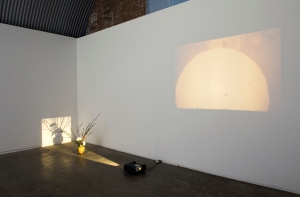The first iteration of Endless Renovation was performed in front of a live audience, where the artist read from a transcript that corresponded to a selection of found images. The images were sourced from a discarded collection of nearly 600 35mm slides she discovered in an alleyway several blocks from her home in Glasgow. Employing a standard art historical method of presentation, Sworn used two slide projectors to show the images, as if empirically comparing one against another. This approach places an emphasis on the visual — precisely where Sworn starts. She states she has no other choice, “all I have to interpret the images is what is held within them …,” but she breaks from this solipsistic mode of inquiry by merging poetic quotes within her own thoughts. In describing the first slide she flows into the words of the American poet John Ashbury, “you cannot take it all in, certain details are already hazy and the mind boggles.” In quoting this phrase, it is almost as if she is alleviating herself and the audience from fully comprehending what we are looking at, acknowledging that she has set herself a difficult task in attempting to characterize the intent of their maker. It is a performativity where the act of conveying her impressions, also shape the narrative and thus the reader’s understanding.
The performative elements of Endless Renovation’s remain central to the exhibition at the CAG. Even though the narration is now recorded and synced to two automated slide projectors, they are active components assembled into a minimal installation with glass and mirror shelving, a flower arrangement, various vases and tailored curtains. Each object, the room’s composition, the scent of flowers and diffuse lighting form the precise setting for the images and the artist’s postulations, but they are also characters that emblematically reflect Sworn’s task of deciphering the images. A selection of vases from different decades is placed on mirrored wall shelves. Semi-weekly one is chosen to hold a floral arrangement made in accordance to the tastes of the era of the vase. The flowers sit on the floor with a light from an antiquated slide projector shining directly on them, casting a sharp silhouette on the wall. Even though the component parts of this piece are resolved, this formal sculpture is speculative. It is the florist’s interpretation of the tastes of an era that ultimately determine it. The layered curtains, with their simple pattern are representative of the light emitted from the lens of the slide projector, defining the beam’s shape as well as giving the immaterial particles substance. The design is symbolic of the artist’s process, which is linked to the viewer’s interpretive experience and a more general understanding of how time – past and present is represented and perceived. This connotation may seem overstated for such a basic pattern, but these concepts are weaved through out Endless Renovation.
The exhibition is a space of projection, starting with Sworn’s reading of the slides — her contemplations about this process as someone who is putting forward their ideas for interpretation while simultaneously interpreting. Sworn begins her unhurried reading of the odd assemblage of images by lingering on the first slide, which she has singled out from its counterparts. For her, it differs in that the others “are composed in a style that might be considered objective” while the first slide is notably a mistake, a slip of the camera capturing a crop of the ceiling and paper lampshade. This error, which could have easily been thrown away by the photographer or ignored by Sworn, shapes the reading of the rest of the images. As she progresses through the slides, there is a point where the images become more consistent; they repeatedly use the same composition, displaying an object in the center of the frame in a blank or austere background. It seems the photographer is an ingenious clock-maker whose designs allow hours, minutes and seconds to be interchangeable.
There is some resolve in discovering this information, but it opens more questions than it answers, and it is here, in this moment of knowing, where Sworn projects a wider spectrum of ideas, about time, perception and memory. To further question hers and the viewer’s assumptions, Sworn imposes subtle interferences. She has positioned the projectors on perpendicular walls, making it difficult to view both images at once and she has incorporated obscure references. Inversely, she has offered some transparency explicitly speaking to her process as well as making the transcript of her narration available. At one point in the narration, Sworn reveals that she also found a dairy marked Temporary diary: June to November 1985 (so the images were not all she had to work with) from which she learnt what car the photographer owned and the dates of his meetings, but it did not reveal a name, and even if it did would that knowledge offer her or the viewer more insight?
Sworn gestures at leaving the work open to boundless readings while also tightens the frame of viewer’s experience. It is her idiosyncratic voice that lays a lyrical and poignant story on to someone else’s images. She selected and ordered the slides as well as the context in which they are shown, but nothing is solidly held in place. In the artist’s words, “these moments of projection produce territories of imagined possibility.” Speculation no matter how tentative still offers meaning, which Sworn has made manifest in the objects, images, her poetic interpretation and the relationships between these things. Jenifer Papararo
Endless Renovation by Corin Sworn exhibited at the Contemporary Art Gallery, Vancouver (November 18, 2011 to January 15, 2012)
